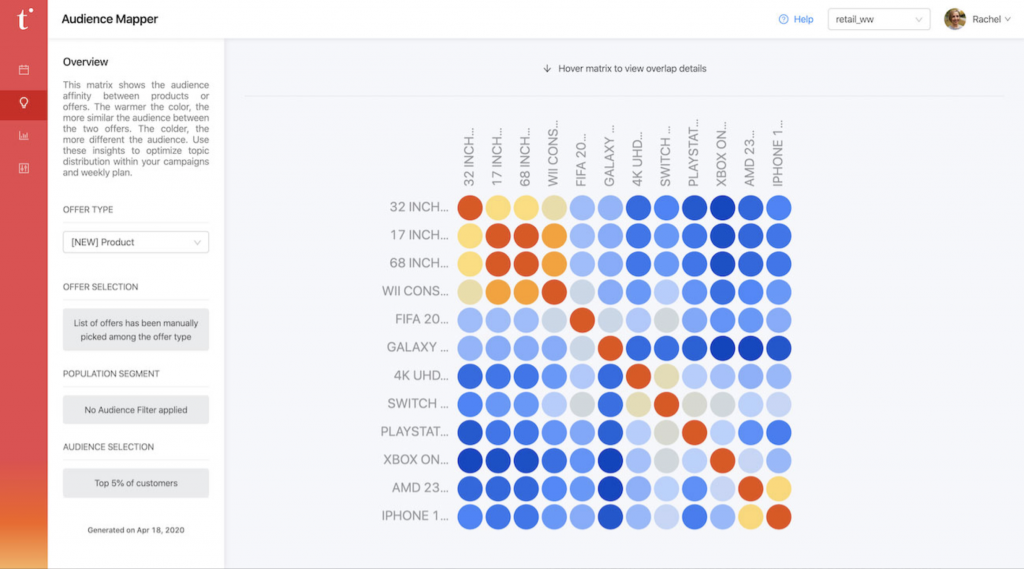Prepare for truly scalable marketing campaigns


Catégorie : Stratégie CRM
When planning your CRM campaigns, you are used to working on detailed monthly plans, defining your action plan based on product releases, on key moments throughout the year, and the priorities of your sales team.
But after defining your campaign plan, one question will surely still be on your mind: I understand the interest of multiplying campaigns through advanced targeting, but concretely, how do I proceed to scale the development of my marketing campaigns? How do I execute this process on a wide scale?
To answer these questions and help you plan scalable marketing campaigns, I decided to lay out the 4 essential steps to create and send out ad hoc campaigns.
The success of a scalable marketing campaign depends on your ability to offer your user base:
If you have a large amount of data, use it intelligently to maximize your opportunities and convert as many customers as possible.
To do this, Tinyclues has developed a set of features that will allow you, dear marketers, to have a real-time vision of the affinity between your catalog and your audience and launch truly scalable marketing campaigns.
Two essential questions that can be answered by the insights and analytics tools available on our platform:
The answers to these questions are key to supporting your marketing strategy and satisfying your Category Management team.
But not only that.
Your creative team will also benefit from these insights to rethink how they approach future communication designs and product launches.
After deploying your strategy, you can ensure the results aren’t lacking by analyzing all the performance indicators available on the platform.
Once you have defined your strategy, the next step is to build your promotional plan.
For many of our clients, unfortunately, the promotional plan often stays the same year in and year out. Without the right tools, it can be difficult to restart a new plan.
To effectively orchestrate your promotional plan, it is essential to push the right offers by asking the right questions:
If you are looking for complementary offers, your goal should be to optimize your marketing fatigue.
“Fatigue management“, that is, balancing how many communications you send, and how often, is a fundamental element of any marketer’s strategy.
It ensures a pleasant experience for your contact base and avoids unsubscribes.
Great news.
On the Splio platform, you will find elements to analyze this pressure and guide your future campaign decisions.
Your promotional plan is ready and validated 🎉
Now it’s time to move on to creating the images and graphics for your communications.
Some of our clients have a creative team dedicated to creating graphics for their communications. Others decide to use no-code tools to build their templates.
How you do it is up to you.
💡 There are plenty of great tools out there. We recommend Dartagnan or Movable Ink.
Each solution has advantages and disadvantages.
Whatever the creation strategy you choose, don’t forget to make your creations responsive.
Responsive? 🤔
All your emails, designs and images must be easy to read on a mobile device.
It is estimated that today, between 50 and 60% of emails are read on mobile devices 🤳🏼
The last step in developing scalable marketing campaigns is targeting and sending your campaigns.
It can be beneficial to increase the number of your campaigns if, and only if, they are addressed to the right customers, at the right time.
For successful targeting, several elements must be taken into account:

In the case of audience overlap, if you observe a high percentage of overlap between two offers, they may be good candidates for the same email, as they complement each other. If the offers cannot live in the same email, it would be smart to send them some time apart.
On the contrary, in case of weak audience overlap, shown in the blue areas on the graph, you will know that two products do not interest the same people. We then advise you to create two different campaigns and in this case, no risk to send them on the same day.
It’s impossible to anticipate all the changes that can occur spontaneously and disrupt your campaign planning.
Nevertheless, by following the few points detailed above, you can succeed in effectively structuring scalable marketing campaigns and anticipating the increasing number of emails you will send.
With the help of your data or CRM teams, you may even be able to automate certain actions to increase efficiency and scale the automation of your CRM programs.
Now, it’s up to you to do the work.